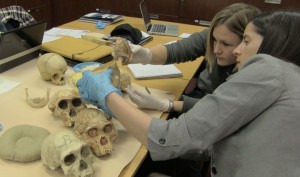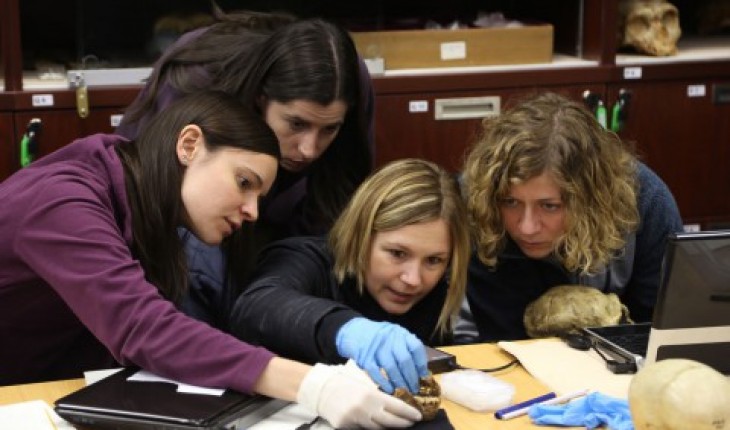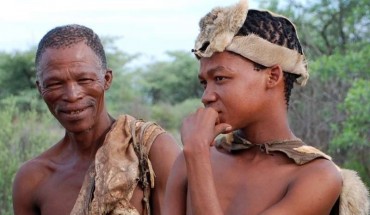From left to right: Myra Laird, Jill Scott, Heather Garvin and Davorka Radovčić studying Homo naledi skull material at the Evolutionary Studies Institute at the U Witwatersrand in Johannesburg, South Africa. Photo courtesy John Hawks/U Wisconsin-Madison.
Anthropology News:
In 2013, two recreational cavers exploring a deep recess of the Rising Star cave in South Africa stumbled across a massive collection of (what appeared to be) human bones. Researchers excavating the site subsequently unearthed the largest paleoanthropological finding in Africa to date: more than 1,500 bones from 15 different individuals—adults to infants, exceptionally well preserved. An international team of collaborators led by Lee Berger and Paul Dirks worked furiously over the next two years to analyze those specimens.
In 2015, they they published the first evidence that the specimens represented a previously-unknown species of extinct hominin, Homo naledi. These individuals (still undated) display a perplexing combination of ancestral and derived features—like small, australopith-sized brains but Homo-like feet—that further complicate our ancestral tree.
Jill E. Scott is a PhD candidate at the University of Iowa who studies skull and facial evolution in Homo, and was acollaborator on the H. naledi project. Below, Scott answers questions about the revolutionary discovery and its relevance for the science of reconstructing human evolution.
One of the hallmarks of the Rising Star project has been the use of social media. The initial team of six female scientists who excavated the Dinaledi Chamber was solicited via a call from Lee Berger on social media. Following the excavation in November 2013, Berger put out a similar call on social media in January of 2014, but this time for early career scientists with data and skill sets applicable to the study of any part of the anatomy of early hominins. I had recently collected my dissertation data by 3D imaging crania and mandibles from fossil hominins and modern humans, so I had a large Middle-Late Pleistocene and Holocene hominin sample to compare to the Dinaledi material. I applied, and in February 2014 was accepted to participate in the workshop. In May I flew to Johannesburg with the other workshop participants. Since most parts of the skeleton were represented in the collection, we divided into groups based upon our anatomical areas of expertise. I worked, and am continuing to work, on describing and analyzing the Homo naledi skull material.
2. What were you most perplexed by, and how did it all fit together in the big picture?
In the beginning of the workshop, each group was focused on looking at our own material to piece together what we had. My team determined that H. naledi’s skull shape is most similar to species of early Homo, but with a smaller, australopith-like brain volume. As the different teams began working together, we saw this again and again: some regions of the anatomy looked markedly more ancestral and australopith-like, while others looked more derived and Homo-like. Still, because we saw this same morphology repeated across specimens, and the specimens were all similarly preserved, it was clear that the collection represented a single population.
From the project’s inception, the senior team was dedicated to making the findings open and accessible to both the scientific community and the public.
Once we started looking across the regions of the skeleton, it was really fascinating and fun to piece together the morphology, behavior and life history of Homo naledi. A prime example comes from looking at the species’ locomotor pattern:Homo naledi has long legs and modern human-like feet, so they were fully bipedal. But the orientation of their shoulder joints and curved fingers suggest they were still great climbers. Meanwhile, other aspects of the palm and wrist suggest a capacity for tool use, similar to Neandertals and modern humans, although we have yet to find tools in direct association with Homo naledi. All in all, it’s a uniquely mosaic morphology.

3. The magnitude of this discovery is unprecedented, given that hominin fossils are usually rare and not well-preserved. But this project also broke the mold in terms of how the evidence was analyzed and presented to the scientific community. Can you tell us about that?
From the project’s inception, the senior team was dedicated to making the findings open and accessible to both the scientific community and the public. Not only were the excavators and workshop participants solicited via social media, but the excavation was also live tweeted, blogged, and shared around the world. Following the transparency of the excavation, the research team was eager to make the scientific research articles open access to continue freely sharing the story of Homo naledi. We were also excited to make 3D scans of the most complete Homo naledi specimens openly available on Morphosource for anyone to download, analyze and 3D print. This approach has provided a more open access model of paleoanthropology that has fostered a sense of community engagement that we hope to see continue and flourish.
4. The Rising Star project included many early career researchers, who surely benefited professionally from the experience. But how did the project benefit from their involvement?

While the senior researchers were more familiar with the process of analyzing and describing new hominin material, the early career scientists also brought in newer data acquisition and analysis techniques. For example, 3D scanning, processing, (semi)landmark acquisition and statistical analysis are techniques with which many early career scientists have abundant experience. Therefore, we were able to function well as a team by using both the traditional and novel methodologies. Additionally, by having such a large team of researchers, we had a much larger comparative sample of primate and human skeletal and hominin fossil data to compare to the Homo naledimaterial. Another added benefit of having such a large team of researchers at various career stages is that we all brought different perspectives from our respective training, leading to a broader, more robust approach to understanding the anatomy and behavior of Homo naledi.
Melanie Martin and Katie Starkweather are Contributing Editors for EAS’s AN column.




